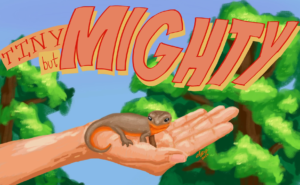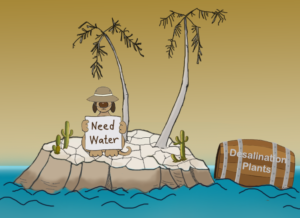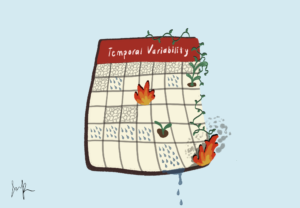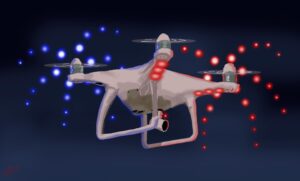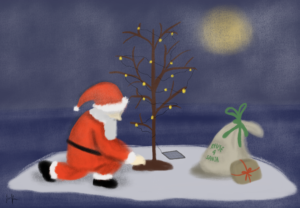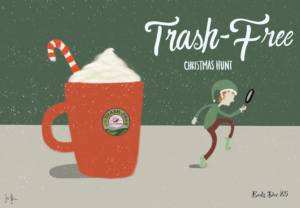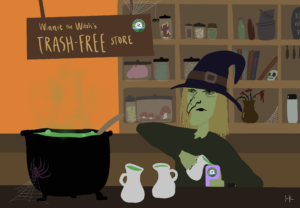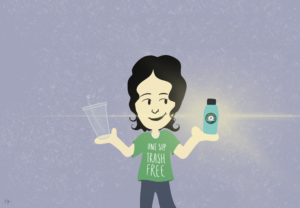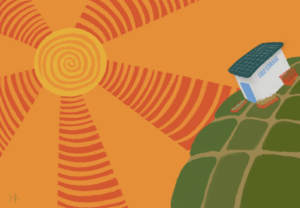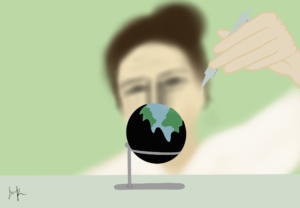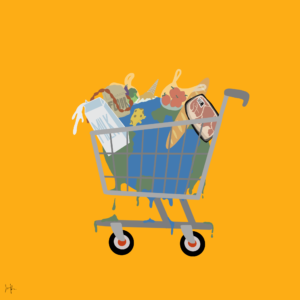Illustrated by Julianne Park. All rights reserved.
By Seoyoung Min
Plastic is accessorizing the ocean. And not in a pretty way.
Each year, about 14 million tons of plastic find their way into the ocean, break down into tiny bits, and dutifully contribute to the estimated 24.4 trillion pieces of microplastic drifting in today’s oceans. It’s like our oceans are becoming a snow globe. Take away the glycerin and glitter, and replace it with ocean water and microplastics—you’ve got yourself a gigantic snow globe.
At first glance, the microplastics seem harmless. I mean, after all, they’re micro. They drift slowly, barely visible, and barely tangible. Obviously, they don’t belong in the ocean, but how could those itty-bitty pieces of plastic do any harm?
Surprise: it’s actually this very characteristic that makes the presence of microplastics in the ocean so extremely harmful. When you have a larger, tangible plastic object floating in the water, cleanup is made easy. They look more menacing, but all you have to do is scoop the object out of the water and properly dispose of it. However, when the trash has been broken down into thousands of pieces barely bigger than a speck of dust, there’s really no way to collect every piece out of the water. And once these pieces are scattered by wave after wave, there’s really no hope.
Furthermore, these microplastics may pose a bigger threat to animals than do the large units of plastic free-floating in the ocean. While sea animals may get caught in or choke on large pieces of plastic, their consumption of microplastics brings much more than the immediate dangers.
When microplastics are unknowingly ingested, they often stay in the animals’ bodies, initiating the damage from within. Most plastics contain toxic chemicals that even humans fall prey to. When consumed by animals, the toxic chemicals live up to their name. Interfering with normal hormone function and organic body chemistry, these chemicals can inhibit growth and development, as well as feeding patterns and behaviors . The destruction stretches to even reproductive ability and genetics, consequently not only affecting the individual animal, but their offspring and the generations beyond.
“Okay, but what are the odds that an animal will accidentally consume plastic in the ocean?” one might say. The odds are… alarmingly high, actually. According to the Center for Biological Diversity, “Not one square mile of surface ocean anywhere on earth is free of plastic pollution.” And considering the statistics for plastic in the ocean and the presence of microplastics, it’s not hard to believe.
The plastic versus ocean battle isn’t new. But despite the countless news stories and movements aiming to call attention to the dire situation, our oceans’ health worsens every year, along with the state of our planet as a whole.
It’s ironic, really. With ever-advancing technological innovation, we should be finding fewer and fewer uses for plastic as other more sustainable materials take its place, yet more and more end up in the ocean every year. Is it because other materials are expensive? Limited? Harder to manufacture? If so, it’s time for manufacturing industries to start prioritizing research to reduce the use of plastics.
That said, don’t wait for the plastic giants to make the first move. Take a moment to consider the unnecessary amount of plastic you use every day. I guarantee you’ll be able to find a plastic product that you can cut out of your day.
As you start this next week, try actively distancing yourself from your daily use of plastic. Take a tote bag for your groceries. Refuse the straw that the waiter offers you with your drink. Bring your actual water bottle to school, rather than a one-time-use, plastic water bottle that your family bought in bulk from Costco.
This change requires a conscious effort from every person to try and move away from a plastic-dependent society. Don’t be a plastic person. It’s not good for the ocean.
Imbler, Sabrina. “In the Ocean, It’s Snowing Microplastics.” The New York Times, The New York Times, 3 Apr. 2022, https://www.nytimes.com/2022/04/03/science/ocean-plastic-animals.html.
Li1, You, et al. “IOPscience.” IOP Conference Series: Earth and Environmental Science, IOP Publishing, 1 Jan. 2021, https://iopscience.iop.org/article/10.1088/1755-1315/631/1/012006.
“Ocean Plastics Pollution.” Ocean Plastics Pollution,
www.biologicaldiversity.org/campaigns/ocean_plastics/. “Twenty-Four Trillion Ocean Microplastics and Counting.” Applied Sciences from Technology Networks, https://www.technologynetworks.com/applied-sciences/news/twenty-four-trillion-ocean-microplastics-and -counting-355279#:~:text=The%20team%20estimates%20there%20are,500%2Dml%20plastic%20water %20bottles.
The views and opinions expressed are those of the authors and do not necessarily reflect nor represent the Earth Chronicles and its editorial board.


